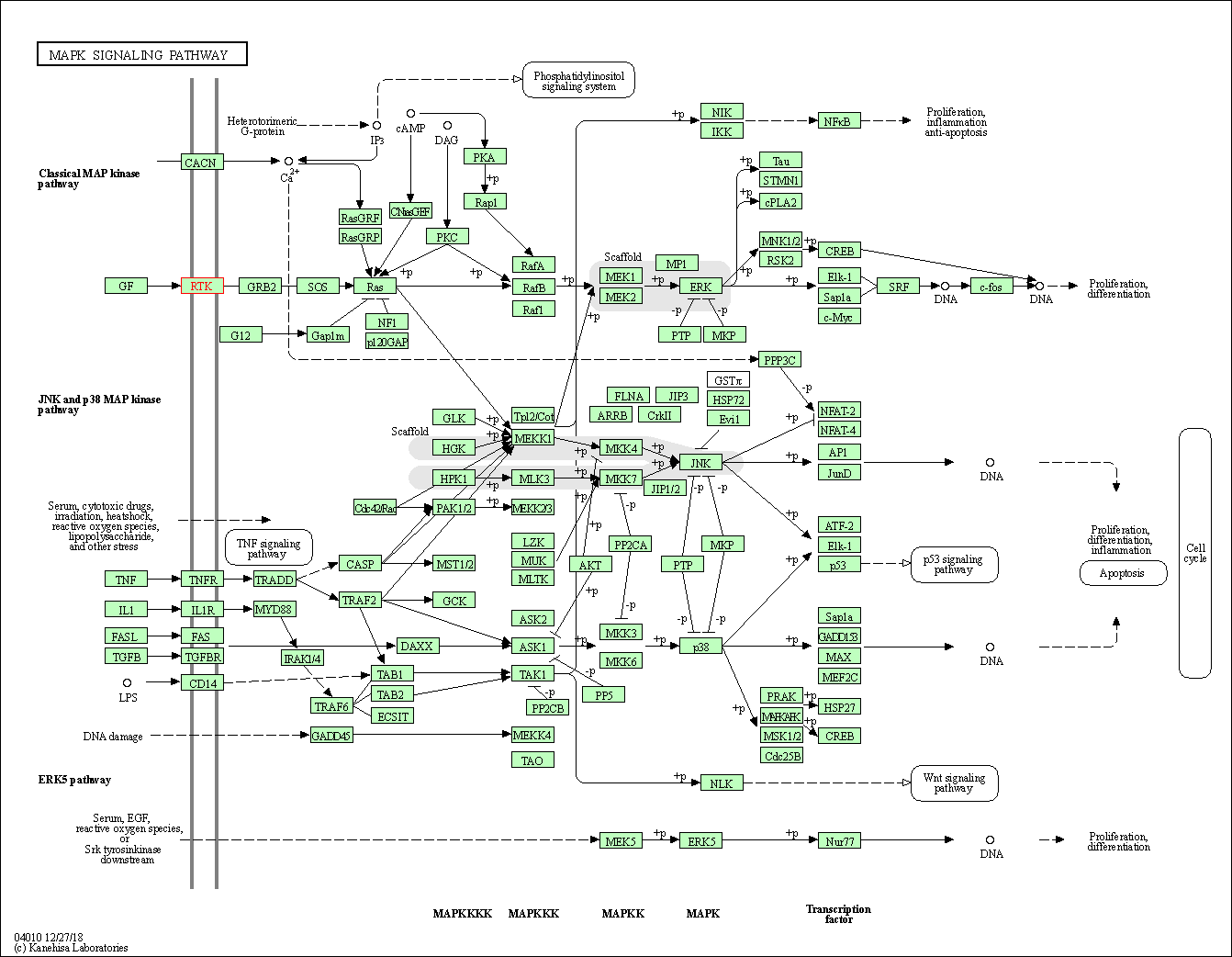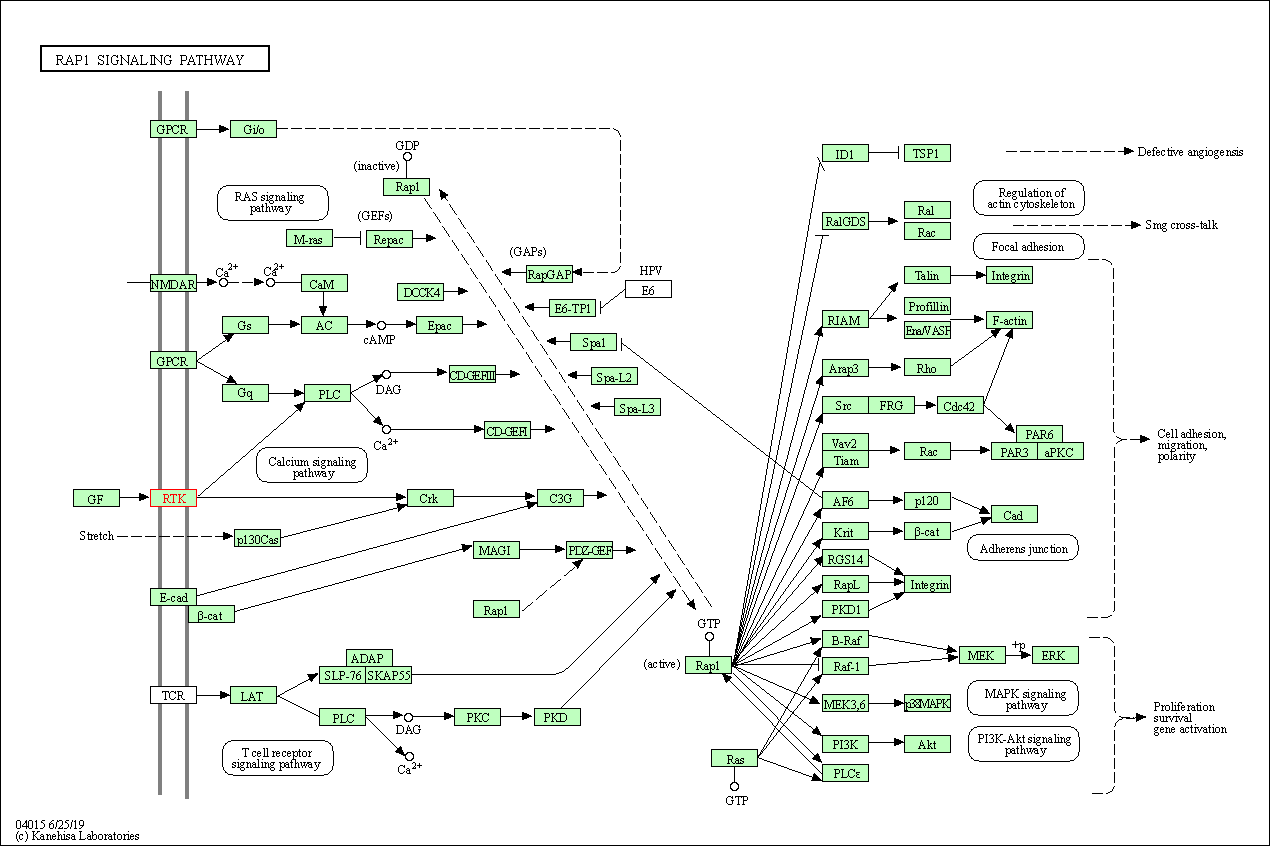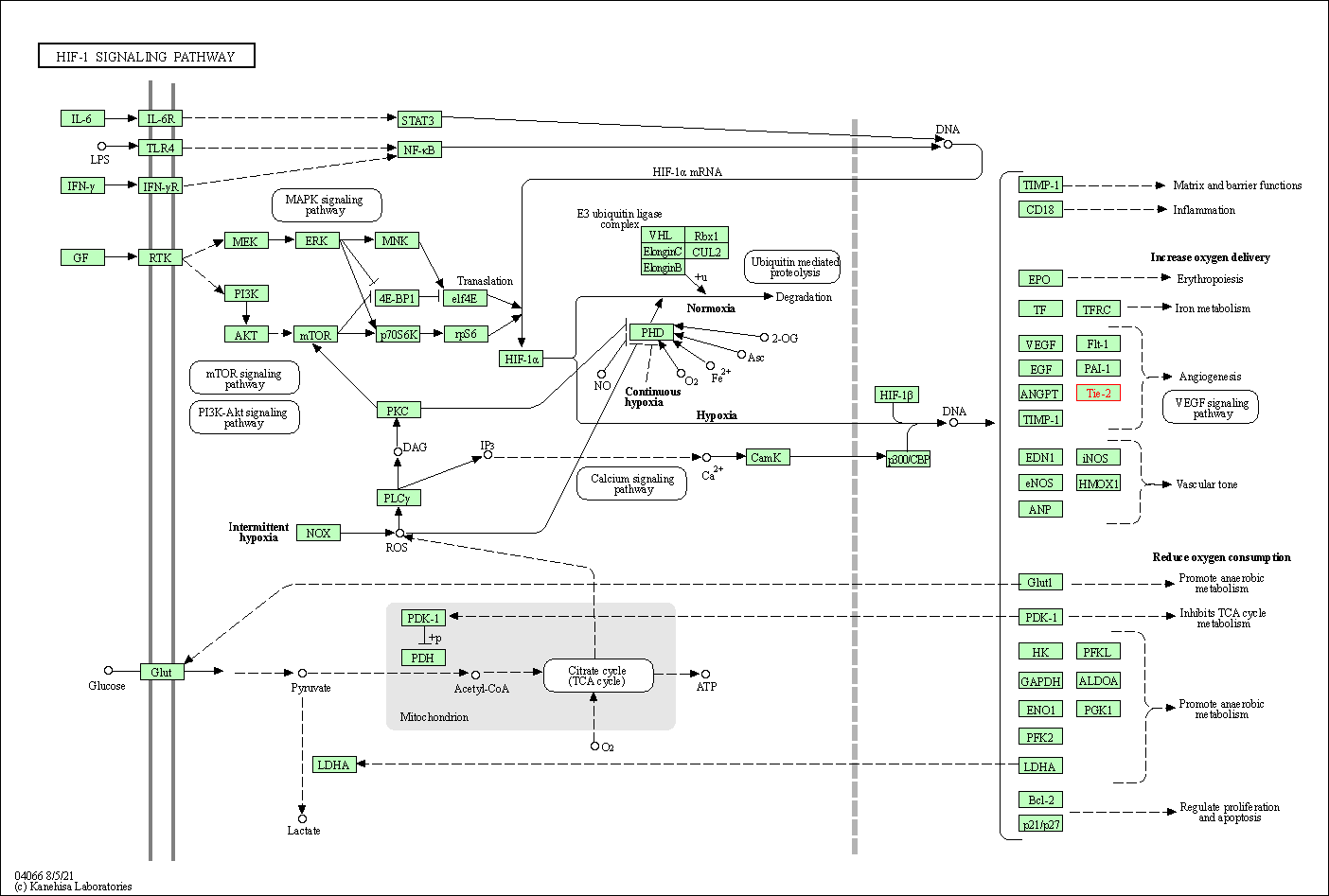Target Information
| Target General Information | Top | |||||
|---|---|---|---|---|---|---|
| Target ID |
T92144
(Former ID: TTDC00161)
|
|||||
| Target Name |
Angiopoietin 1 receptor (TEK)
|
|||||
| Synonyms |
hTIE2; VMCM1; VMCM; Tyrosine-protein kinase receptor TIE-2; Tyrosine-protein kinase receptor TEK; Tyrosine kinase with Ig and EGF homology domains-2; Tunica interna endothelial cell kinase; TIE2; P140 TEK; Endothelial tyrosine kinase; Endothelial Cell-Specific Receptor TIE-2; CD202b antigen; CD202b
Click to Show/Hide
|
|||||
| Gene Name |
TEK
|
|||||
| Target Type |
Clinical trial target
|
[1] | ||||
| Disease | [+] 6 Target-related Diseases | + | ||||
| 1 | Chronic arterial occlusive disease [ICD-11: BD4Z] | |||||
| 2 | Retinopathy [ICD-11: 9B71] | |||||
| 3 | Myeloproliferative neoplasm [ICD-11: 2A20] | |||||
| 4 | Breast cancer [ICD-11: 2C60-2C6Y] | |||||
| 5 | Mature B-cell lymphoma [ICD-11: 2A85] | |||||
| 6 | Solid tumour/cancer [ICD-11: 2A00-2F9Z] | |||||
| Function |
Has anti-inflammatory effects by preventing the leakage of proinflammatory plasma proteins and leukocytes from blood vessels. Required for normal angiogenesis and heart development during embryogenesis. Required for post-natal hematopoiesis. After birth, activates or inhibits angiogenesis, depending on the context. Inhibits angiogenesis and promotes vascular stability in quiescent vessels, where endothelial cells have tight contacts. In quiescent vessels, ANGPT1 oligomers recruit TEK to cell-cell contacts, forming complexes with TEK molecules from adjoining cells, and this leads to preferential activation of phosphatidylinositol 3-kinase and the AKT1 signaling cascades. In migrating endothelial cells that lack cell-cell adhesions, ANGT1 recruits TEK to contacts with the extracellular matrix, leading to the formation of focal adhesion complexes, activation of PTK2/FAK and of the downstream kinases MAPK1/ERK2 and MAPK3/ERK1, and ultimately to the stimulation of sprouting angiogenesis. ANGPT1 signaling triggers receptor dimerization and autophosphorylation at specific tyrosine residues that then serve as binding sites for scaffold proteins and effectors. Signaling is modulated by ANGPT2 that has lower affinity for TEK, can promote TEK autophosphorylation in the absence of ANGPT1, but inhibits ANGPT1-mediated signaling by competing for the same binding site. Signaling is also modulated by formation of heterodimers with TIE1, and by proteolytic processing that gives rise to a soluble TEK extracellular domain. The soluble extracellular domain modulates signaling by functioning as decoy receptor for angiopoietins. TEK phosphorylates DOK2, GRB7, GRB14, PIK3R1; SHC1 and TIE1. Tyrosine-protein kinase that acts as cell-surface receptor for ANGPT1, ANGPT2 and ANGPT4 and regulates angiogenesis, endothelial cell survival, proliferation, migration, adhesion and cell spreading, reorganization of the actin cytoskeleton, but also maintenance of vascular quiescence.
Click to Show/Hide
|
|||||
| BioChemical Class |
Kinase
|
|||||
| UniProt ID | ||||||
| EC Number |
EC 2.7.10.1
|
|||||
| Sequence |
MDSLASLVLCGVSLLLSGTVEGAMDLILINSLPLVSDAETSLTCIASGWRPHEPITIGRD
FEALMNQHQDPLEVTQDVTREWAKKVVWKREKASKINGAYFCEGRVRGEAIRIRTMKMRQ QASFLPATLTMTVDKGDNVNISFKKVLIKEEDAVIYKNGSFIHSVPRHEVPDILEVHLPH AQPQDAGVYSARYIGGNLFTSAFTRLIVRRCEAQKWGPECNHLCTACMNNGVCHEDTGEC ICPPGFMGRTCEKACELHTFGRTCKERCSGQEGCKSYVFCLPDPYGCSCATGWKGLQCNE ACHPGFYGPDCKLRCSCNNGEMCDRFQGCLCSPGWQGLQCEREGIQRMTPKIVDLPDHIE VNSGKFNPICKASGWPLPTNEEMTLVKPDGTVLHPKDFNHTDHFSVAIFTIHRILPPDSG VWVCSVNTVAGMVEKPFNISVKVLPKPLNAPNVIDTGHNFAVINISSEPYFGDGPIKSKK LLYKPVNHYEAWQHIQVTNEIVTLNYLEPRTEYELCVQLVRRGEGGEGHPGPVRRFTTAS IGLPPPRGLNLLPKSQTTLNLTWQPIFPSSEDDFYVEVERRSVQKSDQQNIKVPGNLTSV LLNNLHPREQYVVRARVNTKAQGEWSEDLTAWTLSDILPPQPENIKISNITHSSAVISWT ILDGYSISSITIRYKVQGKNEDQHVDVKIKNATITQYQLKGLEPETAYQVDIFAENNIGS SNPAFSHELVTLPESQAPADLGGGKMLLIAILGSAGMTCLTVLLAFLIILQLKRANVQRR MAQAFQNVREEPAVQFNSGTLALNRKVKNNPDPTIYPVLDWNDIKFQDVIGEGNFGQVLK ARIKKDGLRMDAAIKRMKEYASKDDHRDFAGELEVLCKLGHHPNIINLLGACEHRGYLYL AIEYAPHGNLLDFLRKSRVLETDPAFAIANSTASTLSSQQLLHFAADVARGMDYLSQKQF IHRDLAARNILVGENYVAKIADFGLSRGQEVYVKKTMGRLPVRWMAIESLNYSVYTTNSD VWSYGVLLWEIVSLGGTPYCGMTCAELYEKLPQGYRLEKPLNCDDEVYDLMRQCWREKPY ERPSFAQILVSLNRMLEERKTYVNTTLYEKFTYAGIDCSAEEAA Click to Show/Hide
|
|||||
| 3D Structure | Click to Show 3D Structure of This Target | AlphaFold | ||||
| HIT2.0 ID | T87DGB | |||||
| Drugs and Modes of Action | Top | |||||
|---|---|---|---|---|---|---|
| Clinical Trial Drug(s) | [+] 4 Clinical Trial Drugs | + | ||||
| 1 | AKB-9778 | Drug Info | Phase 2 | Peripheral arterial disease | [2] | |
| 2 | DCC-2036 | Drug Info | Phase 1/2 | Chronic myeloid leukaemia | [3] | |
| 3 | Altiratinib | Drug Info | Phase 1 | Solid tumour/cancer | [4] | |
| 4 | CEP-11981 | Drug Info | Phase 1 | Solid tumour/cancer | [5], [6] | |
| Discontinued Drug(s) | [+] 1 Discontinued Drugs | + | ||||
| 1 | ARRY-614 | Drug Info | Discontinued in Phase 1 | Myelodysplastic syndrome | [7] | |
| Mode of Action | [+] 3 Modes of Action | + | ||||
| Activator | [+] 2 Activator drugs | + | ||||
| 1 | AKB-9778 | Drug Info | [1] | |||
| 2 | ABTAA | Drug Info | [15] | |||
| Inhibitor | [+] 9 Inhibitor drugs | + | ||||
| 1 | DCC-2036 | Drug Info | [8] | |||
| 2 | Altiratinib | Drug Info | [9] | |||
| 3 | (4-Phenoxy-phenyl)-quinazolin-4-yl-amine | Drug Info | [12] | |||
| 4 | 3,4-di-(4-methoxyphenyl)-1H-pyrrole-2,5-dione | Drug Info | [13] | |||
| 5 | 3,4-diphenyl-1H-pyrrole-2,5-dione | Drug Info | [13] | |||
| 6 | 3-(4-methoxyphenyl)-4-phenyl-1H-pyrrole-2,5-dione | Drug Info | [13] | |||
| 7 | 3-(indole-3-yl)-4-phenyl-1H-pyrrole-2,5-dione | Drug Info | [13] | |||
| 8 | A-420983 | Drug Info | [14] | |||
| 9 | PMID21561767C8h | Drug Info | [16] | |||
| Modulator | [+] 3 Modulator drugs | + | ||||
| 1 | CEP-11981 | Drug Info | [10] | |||
| 2 | ARRY-614 | Drug Info | [11] | |||
| 3 | AP-101 | Drug Info | [10] | |||
| Cell-based Target Expression Variations | Top | |||||
|---|---|---|---|---|---|---|
| Cell-based Target Expression Variations | ||||||
| Drug Binding Sites of Target | Top | |||||
|---|---|---|---|---|---|---|
| Ligand Name: DCC-2036 | Ligand Info | |||||
| Structure Description | CRYSTAL STRUCTURE OF TIE2 IN COMPLEX WITH DECIPERA COMPOUND DP1919 | PDB:6MWE | ||||
| Method | X-ray diffraction | Resolution | 2.05 Å | Mutation | No | [17] |
| PDB Sequence |
YPVLDWNDIK
825 FQDVIGEGNF835 GQVLKARIKK845 DGLRMDAAIK855 RMGELEVLCK878 LGHHPNIINL 888 LGACEHRGYL898 YLAIEYAPHG908 NLLDFLRKSR918 VLETDPAFAI928 ANSTASTLSS 938 QQLLHFAADV948 ARGMDYLSQK958 QFIHRDLAAR968 NILVGENYVA978 KIADFGLSRG 988 QEVYKTMGRL1000 PVRWMAIESL1010 NYSVYTTNSD1020 VWSYGVLLWE1030 IVSLGGTPYC 1040 GMTCAELYEK1050 LPQGYRLEKP1060 LNCDDEVYDL1070 MRQCWREKPY1080 ERPSFAQILV 1090 SLNRMLEERK1100 TYVNTTLYEK1110 FTYAGIDCSA1120 EE
|
|||||
|
|
ILE830
3.616
VAL838
3.778
ALA853
3.433
LYS855
3.139
GLY871
4.636
GLU872
2.750
VAL875
3.651
LEU876
3.692
LEU879
4.151
ILE885
3.518
ILE886
3.508
ILE902
3.779
GLU903
3.158
TYR904
3.852
|
|||||
| Ligand Name: 2-(Acetylamino)-2-Deoxy-a-D-Glucopyranose | Ligand Info | |||||
| Structure Description | Tie2 Ligand-Binding Domain Crystal Structure | PDB:2GY5 | ||||
| Method | X-ray diffraction | Resolution | 2.90 Å | Mutation | No | [18] |
| PDB Sequence |
AMDLILINSL
32 PLVSDAETSL42 TCIASGWRPH52 EPITIGRDFE62 ALMNQHQDPL72 EVTQDVTREW 82 AKKVVWKREK92 ASKINGAYFC102 EGRVRGEAIR112 IRTMKMRQQA122 SFLPATLTMT 132 VDKGDNVNIS142 FKKVLIKEED152 AVIYKNGSFI162 HSVPRHEVPD172 ILEVHLPHAQ 182 PQDAGVYSAR192 YIGGNLFTSA202 FTRLIVRRCE212 AQKWGPECNH222 LCTACMNNGV 232 CHEDTGECIC242 PPGFMGRTCE252 KACELHTFGR262 TCKERCSGQE272 GCKSYVFCLP 282 DPYGCSCATG292 WKGLQCNEAC302 HPGFYGPDCK312 LRCSCNNGEM322 CDRFQGCLCS 332 PGWQGLQCER342 EGIPRMTPKI352 VDLPDHIEVN362 SGKFNPICKA372 SGWPLPTNEE 382 MTLVKPDGTV392 LHPKDFNHTD402 HFSVAIFTIH412 RILPPDSGVW422 VCSVNTVAGM 432 VEKPFNISVK442 VLP
|
|||||
|
|
||||||
| Click to View More Binding Site Information of This Target with Different Ligands | ||||||
| Different Human System Profiles of Target | Top |
|---|---|
|
Human Similarity Proteins
of target is determined by comparing the sequence similarity of all human proteins with the target based on BLAST. The similarity proteins for a target are defined as the proteins with E-value < 0.005 and outside the protein families of the target.
A target that has fewer human similarity proteins outside its family is commonly regarded to possess a greater capacity to avoid undesired interactions and thus increase the possibility of finding successful drugs
(Brief Bioinform, 21: 649-662, 2020).
Human Tissue Distribution
of target is determined from a proteomics study that quantified more than 12,000 genes across 32 normal human tissues. Tissue Specificity (TS) score was used to define the enrichment of target across tissues.
The distribution of targets among different tissues or organs need to be taken into consideration when assessing the target druggability, as it is generally accepted that the wider the target distribution, the greater the concern over potential adverse effects
(Nat Rev Drug Discov, 20: 64-81, 2021).
Human Pathway Affiliation
of target is determined by the life-essential pathways provided on KEGG database. The target-affiliated pathways were defined based on the following two criteria (a) the pathways of the studied target should be life-essential for both healthy individuals and patients, and (b) the studied target should occupy an upstream position in the pathways and therefore had the ability to regulate biological function.
Targets involved in a fewer pathways have greater likelihood to be successfully developed, while those associated with more human pathways increase the chance of undesirable interferences with other human processes
(Pharmacol Rev, 58: 259-279, 2006).
Biological Network Descriptors
of target is determined based on a human protein-protein interactions (PPI) network consisting of 9,309 proteins and 52,713 PPIs, which were with a high confidence score of ≥ 0.95 collected from STRING database.
The network properties of targets based on protein-protein interactions (PPIs) have been widely adopted for the assessment of target’s druggability. Proteins with high node degree tend to have a high impact on network function through multiple interactions, while proteins with high betweenness centrality are regarded to be central for communication in interaction networks and regulate the flow of signaling information
(Front Pharmacol, 9, 1245, 2018;
Curr Opin Struct Biol. 44:134-142, 2017).
Human Similarity Proteins
Human Tissue Distribution
Human Pathway Affiliation
Biological Network Descriptors
|
|
|
Note:
If a protein has TS (tissue specficity) scores at least in one tissue >= 2.5, this protein is called tissue-enriched (including tissue-enriched-but-not-specific and tissue-specific). In the plots, the vertical lines are at thresholds 2.5 and 4.
|





| KEGG Pathway | Pathway ID | Affiliated Target | Pathway Map |
|---|---|---|---|
| MAPK signaling pathway | hsa04010 | Affiliated Target |

|
| Class: Environmental Information Processing => Signal transduction | Pathway Hierarchy | ||
| Ras signaling pathway | hsa04014 | Affiliated Target |

|
| Class: Environmental Information Processing => Signal transduction | Pathway Hierarchy | ||
| Rap1 signaling pathway | hsa04015 | Affiliated Target |

|
| Class: Environmental Information Processing => Signal transduction | Pathway Hierarchy | ||
| HIF-1 signaling pathway | hsa04066 | Affiliated Target |

|
| Class: Environmental Information Processing => Signal transduction | Pathway Hierarchy | ||
| PI3K-Akt signaling pathway | hsa04151 | Affiliated Target |

|
| Class: Environmental Information Processing => Signal transduction | Pathway Hierarchy | ||
| Degree | 14 | Degree centrality | 1.50E-03 | Betweenness centrality | 3.02E-04 |
|---|---|---|---|---|---|
| Closeness centrality | 2.32E-01 | Radiality | 1.41E+01 | Clustering coefficient | 1.43E-01 |
| Neighborhood connectivity | 4.28E+01 | Topological coefficient | 1.38E-01 | Eccentricity | 12 |
| Download | Click to Download the Full PPI Network of This Target | ||||
| Chemical Structure based Activity Landscape of Target | Top |
|---|---|
| Drug Property Profile of Target | Top | |
|---|---|---|
| (1) Molecular Weight (mw) based Drug Clustering | (2) Octanol/Water Partition Coefficient (xlogp) based Drug Clustering | |
|
|
||
| (3) Hydrogen Bond Donor Count (hbonddonor) based Drug Clustering | (4) Hydrogen Bond Acceptor Count (hbondacc) based Drug Clustering | |
|
|
||
| (5) Rotatable Bond Count (rotbonds) based Drug Clustering | (6) Topological Polar Surface Area (polararea) based Drug Clustering | |
|
|
||
| "RO5" indicates the cutoff set by lipinski's rule of five; "D123AB" colored in GREEN denotes the no violation of any cutoff in lipinski's rule of five; "D123AB" colored in PURPLE refers to the violation of only one cutoff in lipinski's rule of five; "D123AB" colored in BLACK represents the violation of more than one cutoffs in lipinski's rule of five | ||
| Co-Targets | Top | |||||
|---|---|---|---|---|---|---|
| Co-Targets | ||||||
| Target Poor or Non Binders | Top | |||||
|---|---|---|---|---|---|---|
| Target Poor or Non Binders | ||||||
| Target Regulators | Top | |||||
|---|---|---|---|---|---|---|
| Target-regulating microRNAs | ||||||
| Target-interacting Proteins | ||||||
| Target Profiles in Patients | Top | |||||
|---|---|---|---|---|---|---|
| Target Expression Profile (TEP) |
||||||
| Target Affiliated Biological Pathways | Top | |||||
|---|---|---|---|---|---|---|
| KEGG Pathway | [+] 5 KEGG Pathways | + | ||||
| 1 | Ras signaling pathway | |||||
| 2 | Rap1 signaling pathway | |||||
| 3 | HIF-1 signaling pathway | |||||
| 4 | PI3K-Akt signaling pathway | |||||
| 5 | Rheumatoid arthritis | |||||
| NetPath Pathway | [+] 1 NetPath Pathways | + | ||||
| 1 | Wnt Signaling Pathway | |||||
| Panther Pathway | [+] 1 Panther Pathways | + | ||||
| 1 | Angiogenesis | |||||
| PID Pathway | [+] 2 PID Pathways | + | ||||
| 1 | Angiopoietin receptor Tie2-mediated signaling | |||||
| 2 | SHP2 signaling | |||||
| Reactome | [+] 2 Reactome Pathways | + | ||||
| 1 | Tie2 Signaling | |||||
| 2 | RAF/MAP kinase cascade | |||||
| WikiPathways | [+] 3 WikiPathways | + | ||||
| 1 | Wnt Signaling Pathway Netpath | |||||
| 2 | Cell surface interactions at the vascular wall | |||||
| 3 | Angiogenesis | |||||
| Target-Related Models and Studies | Top | |||||
|---|---|---|---|---|---|---|
| Target Validation | ||||||
| References | Top | |||||
|---|---|---|---|---|---|---|
| REF 1 | Clinical pipeline report, company report or official report of the Pharmaceutical Research and Manufacturers of America (PhRMA) | |||||
| REF 2 | ClinicalTrials.gov (NCT02387788) Open Label Study to Assess the Efficacy and Safety of AKB-9778 in Subjects With Macular Edema Due to RVO. U.S. National Institutes of Health. | |||||
| REF 3 | ClinicalTrials.gov (NCT00827138) Study Safety and Preliminary Efficacy of DCC-2036 in Patients With Leukemias (Ph+ CML With T315I Mutation). U.S. National Institutes of Health. | |||||
| REF 4 | Trusted, scientifically sound profiles of drug programs, clinical trials, safety reports, and company deals, written by scientists. Springer. 2015. Adis Insight (drug id 800040094) | |||||
| REF 5 | URL: http://www.guidetopharmacology.org Nucleic Acids Res. 2015 Oct 12. pii: gkv1037. The IUPHAR/BPS Guide to PHARMACOLOGY in 2016: towards curated quantitative interactions between 1300 protein targets and 6000 ligands. (Ligand id: 8189). | |||||
| REF 6 | ClinicalTrials.gov (NCT00875264) Open-Label Study to Determine the Maximum Tolerated Oral Dose of the Kinase Inhibitor CEP-11981 in Patients With Advanced Cancer. U.S. National Institutes of Health. | |||||
| REF 7 | Trusted, scientifically sound profiles of drug programs, clinical trials, safety reports, and company deals, written by scientists. Springer. 2015. Adis Insight (drug id 800026289) | |||||
| REF 8 | Clinical pipeline report, company report or official report of the Pharmaceutical Research and Manufacturers of America (PhRMA) | |||||
| REF 9 | Clinical pipeline report, company report or official report of Deciphera Pharmaceuticals. | |||||
| REF 10 | URL: http://www.guidetopharmacology.org Nucleic Acids Res. 2015 Oct 12. pii: gkv1037. The IUPHAR/BPS Guide to PHARMACOLOGY in 2016: towards curated quantitative interactions between 1300 protein targets and 6000 ligands. (Target id: 1842). | |||||
| REF 11 | Cmpany report (Arraybiopharma) | |||||
| REF 12 | Pyrrolo[2,3-d]pyrimidines containing an extended 5-substituent as potent and selective inhibitors of lck I. Bioorg Med Chem Lett. 2000 Oct 2;10(19):2167-70. | |||||
| REF 13 | Design, synthesis, and biological evaluation of 3,4-diarylmaleimides as angiogenesis inhibitors. J Med Chem. 2006 Feb 23;49(4):1271-81. | |||||
| REF 14 | A-420983: a potent, orally active inhibitor of lck with efficacy in a model of transplant rejection. Bioorg Med Chem Lett. 2004 May 17;14(10):2613-6. | |||||
| REF 15 | Amelioration of sepsis by TIE2 activation-induced vascular protection. Sci Transl Med. 2016 Apr 20;8(335):335ra55. | |||||
| REF 16 | Discovery of 5-(arenethynyl) hetero-monocyclic derivatives as potent inhibitors of BCR-ABL including the T315I gatekeeper mutant. Bioorg Med Chem Lett. 2011 Jun 15;21(12):3743-8. | |||||
| REF 17 | The Selective Tie2 Inhibitor Rebastinib Blocks Recruitment and Function of Tie2(Hi) Macrophages in Breast Cancer and Pancreatic Neuroendocrine Tumors. Mol Cancer Ther. 2017 Nov;16(11):2486-2501. | |||||
| REF 18 | Crystal structures of the Tie2 receptor ectodomain and the angiopoietin-2-Tie2 complex. Nat Struct Mol Biol. 2006 Jun;13(6):524-32. | |||||
If You Find Any Error in Data or Bug in Web Service, Please Kindly Report It to Dr. Zhou and Dr. Zhang.

